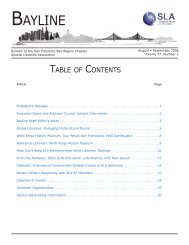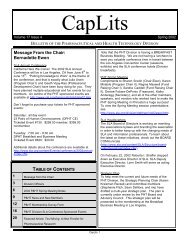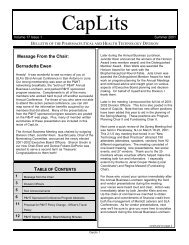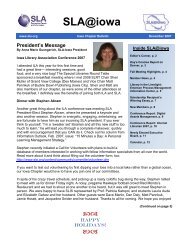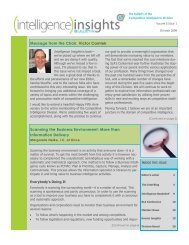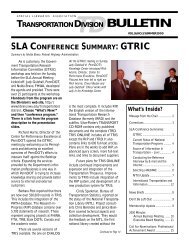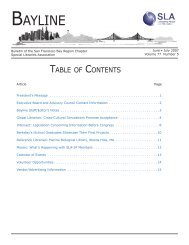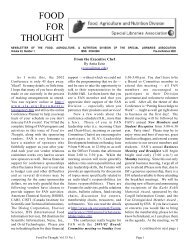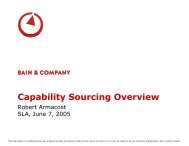PHTD 2012 Spring Meeting - units.sla.org
PHTD 2012 Spring Meeting - units.sla.org
PHTD 2012 Spring Meeting - units.sla.org
You also want an ePaper? Increase the reach of your titles
YUMPU automatically turns print PDFs into web optimized ePapers that Google loves.
<strong>PHTD</strong> <strong>2012</strong> <strong>Spring</strong> <strong>Meeting</strong>, Baltimore MD<br />
48<br />
What Are YOUR Business Needs?<br />
Whether innovation, strategic, regulatory, or financial - Elsevier Business Intelligence<br />
has publications, conferences and databases that can help you meet them.<br />
Elsevier Business Intelligence products come from<br />
on-the-ground analysts around the world — and are read by both<br />
senior executives in industry, and regulators and policymakers. With<br />
an ever-expanding global editorial staff, we have access to exclusive<br />
insights and information you won’t find in any mainstream news media.<br />
See below for information about our products. To request a sample issue or additional<br />
product or pricing information, please visit www.elsevierbi.com or contact:<br />
+1(908) 547-2187 * ebisales@elsevier.com<br />
*mention you are a SLA DPHT member.<br />
STA TA T RT R T- TUP -<br />
Elsevier Business Intelligence | www.ElsevierBI.com | Vol. 16 No. 10 | NOVEMBER 2011<br />
16<br />
Emerging<br />
Medical<br />
Ventures<br />
Cumulative Percentage Change from 2011<br />
“The Pink Sheet” DAILY<br />
Daily, in-depth analysis of the<br />
key developments shaping the<br />
biopharma industry.<br />
|<br />
| | |<br />
|<br />
Where Are They Now?<br />
Checking In With Four Alzheimer’s<br />
Disease Start-Ups<br />
1 VALUATION WATCH<br />
Biotech IPOs: Rewards Worth<br />
The Risk<br />
3 VENTURE ’ROUND<br />
INSIDE:<br />
The Next “Surge”:<br />
BY MARC WORTMAN With its driving theory in question and a sharp<br />
Quanticel/Celgene: The Importance Drug Shortages<br />
aversion to risk infecting the space, Alzheimer’s disease drug developers<br />
Of Linking A Financing And An Exit ■ page 30<br />
face deep investor skepticism even as the disorder gains prominence<br />
as one of the gravest public health threats to an aging population.<br />
As VC Industry Contracts, Limited<br />
Yet four previously profi led companies have found their way forward<br />
Partners Look To Specialists<br />
in challenging times.<br />
Jumpstarting US Device Trials: FDA<br />
Makes Effort In New Draft Guidelines<br />
Mobile Health Promises<br />
vol. 6, no. 11 december 2011 elsevier business intelligence www.ElsevierBI.com<br />
24 To Uproot, Uplift Medical Devices 10 START-UP QUARTERLY<br />
BY MARY STUART The health care industry is being swept up in a<br />
STATISTICS, Q3 2011 C O L U M N S<br />
technological twister, again. Ten years ago, Vytorin it was the Internet. Revived? Today,<br />
it’s mobile technology. How are medical device Merck’s companies, cholesterol drug start-ups is poised to add a unique claim to improve outcomes Free Speech ............................. 2<br />
and investors harnessing this power to create in as better many devices, as 19 million improved Americans, even 14 though CAPITAL there still MATTERS isn’t data to<br />
clinical outcomes and richer fi nancial returns? answer critics about whether ezetimibe actually Morningside adds clinical Group: benefit Billionaire to Gerald FDA Beat ................................. 26<br />
conventional statin therapy. How did Merck persuade Chan an Bets advisory Early committee On Chinese Biotech<br />
to support the claim? The company didn’t; Oxford’s SHARP study team did.<br />
CMS Beat ................................ 32<br />
■ page 6<br />
VC-Backed GI Start-Ups<br />
61 SCIENCE MATTERS<br />
Personalizing Standard Street Smarts .......................... 36<br />
PROFILES See Opportunity The In Public IBS Policy Implications Chemotherapy And of A Potential New<br />
38 The ghosts of failed drugs like Zelnorm and Lotronex still haunt the fi eld, but private<br />
Combination Treatment Strategy Pointed Elsevier Business View Intelligence ........................... 43<br />
the Abbott Split<br />
www.ElsevierBI.com<br />
companies are confi dent they can satisfy safety-focused regulators – and ink lucrative<br />
partnerships, too – by focusing on novel, more selective, Abbott’s targets. decision to spin-off proprietary pharmaceuticals as a stand-alone<br />
company is all about Wall Street: investors cheered 62 ON the THE move MOVE for “unlocking Interventional Cardiology<br />
41 Altheus expects chemical synergy to improve ulcerative value” colitis. by removing the giant shadow cast by Humira Who’s over Going the Where diversified In Biopharma REVA: In Bioresorbable Stents,<br />
base business. But it is also an important touchstone for all the key public<br />
43 AltheRx’s solabegron: a safe and highly selective therapy for IBS and OAB.<br />
And Medtech Start-Ups “Patent As Things reform Change, is a huge Will The win.”<br />
policy themes playing out in the biopharma space after health care reform.<br />
45 Ardelyx modulates mineral absorption to treat IBS.<br />
Value Remain John Lechleiter, The Same?<br />
■ page 14<br />
CEO, Eli Lilly & Co.<br />
70 EXECUTIVE SUMMARIES By Stephen Levin<br />
47 Second Genome mines the microbiome to discover GI targets.<br />
Hospira and FDA<br />
Start-Ups Across Health Care Hospira’s new CEO Mike Ball was charting a global expansion and touting<br />
a move into biosimilars. Then the lingering 64 quality control discussions with<br />
50 InfraScan’s portable head scanner detects intracranial FDA hematoma. caught up with the company and forced their way to the top of his d a s h b O arD<br />
agenda. That may be an important step for the company<br />
51 PlaqueTec pursues vulnerable plaque biomarkers and druggable targets. DEALS<br />
in the long-term.<br />
■ page 36<br />
Recent Financings Of The Part D Problem<br />
54 Prosonix aims for robust and accurate respiratory drug delivery.<br />
Private Companies And Costs of the Medicare Rx program are projected to soar<br />
57 Veracyte pioneers molecular cytology.<br />
Tech Transfers Between over time.<br />
A New Blueprint for Market Access<br />
Academia And Industry<br />
60 EMERGINGS IN BRIEF: 480 Biomedical, Alafair Biosciences, The access Blaze and Bioscience reimbursement environment is becoming more<br />
Cumulative Growth of Net Medicare Parts A, B, & D (2011-21)<br />
and Oncobiologics<br />
challenging as public and private payers scrutinize the value and cost<br />
80%<br />
of pharmaceuticals more than ever. Increasingly, robust proof of clinical<br />
and/or economic value is being required as a condition of coverage.<br />
60%<br />
Pharmaceutical companies must make <strong>org</strong>anizational changes to adjust.<br />
Part D<br />
Part B<br />
■ page 20<br />
40%<br />
20%<br />
Don’t Wait For The Next Issue!<br />
Part A<br />
0%<br />
Now you can get RPM’s analytical<br />
-20%<br />
coverage more rapidly on the web –<br />
2011 <strong>2012</strong> 2013 2014 2015 2016 2017 2018 2019 2020 2021<br />
NOVEMBER 2011<br />
Vol. 29, No. 10<br />
Biopharmaceuticals<br />
Endovascular Devices<br />
J&J’s Zytiga –<br />
Lombard Medical:<br />
The Anatomy Of<br />
At Long Last, Turning<br />
A Cancer Launch<br />
The Corner In EVAR<br />
By MichaeL GoodMan<br />
By david caSSak<br />
BIOPHARMACEUTICALS<br />
Biosimilars:<br />
A New Kind Of<br />
Innovation<br />
For several recent entrants, the biosimilars<br />
game isn’t just about creating copies; it’s about<br />
www.ElsevierBI.com<br />
SOURCE: Bipartisan Policy Center<br />
promoting and branding a new kind of hybrid<br />
proposition where the innovation isn’t in the<br />
molecule, but in how you make it, position it,<br />
and support it. In this sense biosimilars reflect<br />
the broader payor-driven push away from<br />
scientific novelty toward a focus on value.<br />
PharmAsia News<br />
Highly specialized industry insight<br />
on the Asian marketplace, plus<br />
coverage of business and regulatory<br />
developments. Offering around-the<br />
clock newsfeeds from Asia.<br />
by MELANIE SENIOR<br />
The Abbott Split Up: Who Wins? • Somber NASS Reflects Challenges Facing Spine Industry<br />
Elsevier Business Intelligence<br />
$730 A Year<br />
‘‘The Silver Sheet’’<br />
Start-Up<br />
In-depth profiles of leading-edge<br />
companies and technologies, including<br />
the most important new trends in<br />
the biopharma, medical device and<br />
diagnostics industries.<br />
“The Pink Sheet”<br />
Expert, in-depth insight and analysis of biopharma<br />
regulatory, reimbursement and business developments.<br />
“The Gray Sheet”<br />
Weekly, in-depth specialized coverage of the medical<br />
device and diagnostic industries.<br />
“The Gold Sheet”<br />
Insightful analysis to help you comply with U.S. and<br />
international pharmaceutical manufacturing QA/QC<br />
requirements.<br />
“The Silver Sheet”<br />
In-depth news and analysis of FDA’s interpretation and<br />
enforcement of the Quality System Regulation.<br />
IN VIVO<br />
The premier strategic business<br />
resource for the biopharma, medical<br />
device, and diagnostics industries.<br />
The RPM Report<br />
Actionable insight on regulation, policy, FDA and CMS to apply directly to<br />
your decision-making.<br />
PUbLISHeD<br />
moNTHLY<br />
|<br />
i i i i<br />
. . . . . . . . . . .<br />
.<br />
.<br />
.<br />
. .<br />
.<br />
. . . . . . . . . . . . . . .<br />
.<br />
. . . . . . . . . . . . . . . .<br />
. .<br />
.<br />
.<br />
.<br />
.<br />
M E D I C A L D E V I C E Q U A L I T Y C O N T R O L<br />
Founded 1996 Vol. 15, No. 11<br />
November 2011<br />
news this month Three Barriers To Device Quality And<br />
A new FDA report finds three<br />
major barriers to medical device<br />
quality: a misalignment between<br />
FDA investigator priorities and the factors<br />
that truly drive product quality; a lack of<br />
information on how products compare<br />
with one another in terms of quality; and<br />
manufacturers’ failure to use appropriate<br />
risk management tools at a time of<br />
increasing device complexity. The report,<br />
“Understanding Barriers to Medical Device<br />
Elsevier Business Intelligence<br />
What FDA, Industry Might $1,015 A Year Do About Them<br />
Shawn M. SchMitt sm.schmitt@elsevier.com<br />
DA is reassessing its facility inspection strategy after hearing that industry<br />
believes the agency places manufacturer adherence to the Quality System<br />
F Regulation ahead of product quality. ‘‘The Gold Sheet’’<br />
Manufacturers’ perceptions that they must throw an exorbitant amount of resources<br />
at low-risk problems found during agency inspections is just one of three<br />
PHARMACEUTICAL & BIOTECHNOLOGY QUALITY CONTROL<br />
roadblocks to quality outlined in “Understanding Barriers to Medical Device Quality,”<br />
an FDA report released Oct. 31.<br />
November 2011<br />
“What FDA inspects for becomes important, and what’s important gets done [by<br />
PUbLISHeD<br />
moNTHLY<br />
Vol. 45, No. 11<br />
Quality,” lists possible solutions for FDA and manufacturers], so it’s critical that we are inspecting for the right things,” CDRH<br />
industry. “Identifying and addressing bar- Director Jeffrey Shuren said.<br />
news this issue Opportunities to Statistically Mine<br />
riers to medical device quality can improve<br />
“We want to make sure ... we’re not focusing on the minor stuff so we don’t divert<br />
public health outcomes while also improv- companies’ attention to those things that matter What less,” large he said. samples “Instead, could [we tell need FDA PAT Data for Release Testing Explored<br />
ing a company’s bottom line and allowing<br />
Elsevier Business Intelligence<br />
to] get them focused – and ourselves focused – on what matters most.”<br />
CDRH to better utilize its resources,” CDRH<br />
The streams PUbLISHeD<br />
of process analytical data that<br />
$1,935 A Year<br />
Joanne S. eglovitch J.eglovitch@elSevier.com<br />
Director Jeffrey Shuren said. A goal for FDA One way FDA might modify its inspectional approach drug makers is to instruct increasingly WeeKLY<br />
its investiga- produce could<br />
tors to place more emphasis on QSR requirements support that regulatory greatly affect compliance the quality by showing<br />
anufacturers, compendial authorities and FDA officials recently explored<br />
is to collaborate with industry to create a<br />
set of robust, commonly understood quality of devices – such as design controls and supplier that processes controls – are and validated less weight and batches on<br />
ways the pharmaceutical industry could use sophisticated statistical meth-<br />
practices ...........................Cover<br />
areas of the regulation that are not as quality-centered. releasable. A recent PQRI meeting explored M ods to unlock the regulatory compliance potential of vast amounts of pro-<br />
how to make it happen. ............................Cover cess analytical data it is generating.<br />
‘‘The Further, inspections could be structured to concentrate more on products with a<br />
FDA quality report Gray singles out Sheet’’ ®<br />
history of quality failures, such as infusion pumps. Inspections also should target Discussions at a recent Product Quality Research Institute workshop focused<br />
seven areas where manufacturers can<br />
known company-specific quality weaknesses, the A coming report out notes. party for China’s GMPs mainly on batch release testing for content uniformity. Manufacturers typically<br />
boost quality ...........................5<br />
m e d c a l d e v c e s a n d d a g n o s t c s China is sending inspectors abroad to see<br />
rely on a compendial end-product testing method that can demonstrate compli-<br />
The report is an attempt by CDRH to understand why device quality problems<br />
Warning Letters<br />
how the rest<br />
ance of a 10- to 30-tablet sample, but that does not address the likelihood that<br />
continue to occur. Offering a menu of action items, it is Vol. of<br />
intended 37, the No. world 50 complies with<br />
as a starting the sample actually represents the batch.<br />
December Respironics cited 12, for 2011<br />
its new GMPs so they can learn how to in-<br />
MDR violations in point for the agency and industry as they work to remove quality hurdles.<br />
spect that kind of quality into China’s do- They talked about alternatives for statistically analyzing these small-sample re-<br />
relation to its Trilogy Continuous Venti-<br />
Manufacturer use of any recommendations in mestic the quality industry. report What is will completely this mean for sults to gain greater batch-wide insights.<br />
lators; SterilMed was selling its Femo- voluntary; FDA has no authority to prescribe to multinational firms how to corporations? make their products. ...................... 8<br />
Stop Gold compression device without<br />
But the main focus of the Sept. 12-13 sample size workshop in Bethesda, Md., was<br />
top news CardioMEMS’ Heart Failure Monitor<br />
Continued > Page 3<br />
FDA approval ......................10<br />
on tapping the treasure trove of process analytical data that constitutes much<br />
Foiled At panel By FDA Inspection FDA deferring CMC changes ‘wish list’ larger and therefore more representative data sets.<br />
CMS pre-payment Close-Out reviews Letters ..................12<br />
In Their Words FDA explains why it’s setting aside industry’s<br />
The existing compendial approach under USP General Chapter 905, Uniformity<br />
Anxiety may be unfounded Findings Of Study Bias<br />
‘wish list’ as it focuses on clarifying draft<br />
News In Brief<br />
of Dosage Units (UDU), for tablets and capsules is also not relevant in the new<br />
Zach Miners guidance on downgrading CMC changes to<br />
The jury is still out on whether Medicare<br />
z.miners@elsevier.com<br />
This quality initiative will allow small firms to dedicate their<br />
quality-by-design manufacturing paradigm where in-process testing and control<br />
Former FDA Office of Compliance Direc- “<br />
annually reportable. PhRMA complains the<br />
pre-payment reviews will significantly<br />
tor Tim Ulatowski joins Becker Consult- n FDA panel limited meeting resources last week on to CardioMEMS areas that Inc they .’s draft PMA know would for its are actually Champion priorities increase supplement to fil- is emphasized, they say.<br />
reduce procedure volumes and device<br />
ing, while former compliance office implantable FDA heart – and failure that monitor is as was beneficial dominated to not them ing by requirements..................................................12<br />
the as firm’s it is to clinical<br />
consumption, but hospital execs say<br />
firms like<br />
USP officials say that they are mulling over the possibility of creating a new chap-<br />
official Larry Spears jumps from Becker A data but by findings from FDA’s pre-market clinical-site inspections pointing<br />
that outcome is unlikely .10<br />
medtronic and Johnson & Johnson.<br />
ter addressing content uniformity of large samples. Meanwhile the European<br />
to Deloitte; AAMI continues to address to bias in that data FDA wants generics more equivalent Pharmacopeia issued a proposal this year outlining new requirements for large<br />
”<br />
“alarm fatigue” .....................14<br />
The result: CardioMEMS appears to be facing an uphill battle at best for ap-<br />
– Steven Silverman, director, CDRH Office of Compliance<br />
samples.<br />
Diagnostic patent or law of nature?<br />
proval That is a disappointing surprise not only for Atlanta-based<br />
No more holding<br />
CardioMEMS,<br />
your nose and trying to<br />
but also for St Jude Medical, which holds a 19% ownership<br />
choke<br />
stake<br />
down<br />
in the<br />
smelly,<br />
firm and<br />
bulky generics. FDA One approach pharmaceutical manufacturers are talking about is adopting the<br />
Mayo v. Prometheus case argued<br />
has touted the technology as a major opportunity for its business<br />
says it wants<br />
(See<br />
them<br />
“St Jude:<br />
the same size, taste and American National Standards Institute E2709 standard, otherwise known as the<br />
before Supreme Court<br />
CardioMEMS’ Heart Failure Data Reflects Major Opportunity”<br />
smell<br />
— “The<br />
as the<br />
Gray<br />
reference<br />
Sheet,”<br />
listed drugs. ............14 CUDAL method, which ASTM approved in 2009.<br />
The court To struggled sign up last for week FREE to map ONLINE Feb ACCESS, 14, 2011 .) go to: www.ElsevierBI.com/publications/The-Silver-Sheet Officials say that CUDAL is a highly effective method in identifying nonconform-<br />
out rules for the types of method<br />
ANDAs will need more stability data ing material for both large and small sample sizes. This method can be used to<br />
claims, particularly for diagnostic<br />
FDA is drafting guidance that will call for ge- assess the likelihood that particular sample results are representative of entire<br />
methods, that should be eligible for<br />
nerics firms to submit up to 12 months of sta- batches, and could play a role in process validation studies and in lot release.<br />
patent protection 12<br />
bility data with their ANDAs, instead of just the<br />
FDA officials also pointed to published simulation studies showing that the ASTM<br />
three months of data currently required. And<br />
E2709 method is superior to the USP 905 chapter for detecting batch defects.<br />
New on the mHealth scene<br />
industry has a lot of questions about it. ...........15<br />
Qualcomm launches wireless<br />
Other statistical approaches for handling large sample sizes discussed at the<br />
health business<br />
Telecommunications firm unveils Qualcomm<br />
Life, a new health care sub-<br />
What ICH Q1A means for generics<br />
conference included parametric tolerance interval test (PTIT) and nonparametric<br />
counting test methods. Both approaches can be used to ensure dose uniformity<br />
Current stability testing requirements vs.<br />
at lot release.<br />
what ICH Q1A requires. ......................................18<br />
sidiary The company’s first product,<br />
pictured below, is a platform that will<br />
CardioMEMS’ Champion heart failure sensor is implanted via catheter to continuously<br />
Continued > Page 3<br />
allow wireless medical devices to send<br />
take pulmonary artery pressure measurements.<br />
patient data from the home to a cloud-<br />
To sign up for FREE ONLINE ACCESS, go to: www.ElsevierBI.com/publications/The-Gold-Sheet<br />
based storage site .20<br />
FDA’s Circulatory System Devices panel voted 6-4 that the benefits of Champion<br />
do not outweigh its risk at the Dec 8 meeting in Gaithersburg, Md<br />
And in spite of the fact that the trial met its primary endpoint of reducing<br />
heart-failure hospitalizations, panel members voted 3-7 against device effectiveness<br />
due largely to a level of interaction between the sponsor and clinical site<br />
investigators that FDA said went beyond the protocol outlined in the firm’s PMA<br />
submission<br />
This “auxiliary management,” as panelists came to call it, included telephone<br />
calls and certain e-mails offering medical therapy advice from CardioMEMS nurses<br />
to study investigators Most panel members agreed they could not tease out the<br />
clinical benefits of the device from the benefits of the sponsor-generated therapy<br />
recommendations<br />
“There are confounding factors that make it impossible to know if the device alone<br />
can explain the benefit,” concluded David J Slotwiner, of Long I<strong>sla</strong>nd Jewish Medical<br />
Table of Contents > page 3<br />
Story continues > Page 5<br />
To sign up for FREE ONLINE ACCESS, go to: www.ElsevierBI.com/publications/The-Gray-Sheet<br />
Elsevier Business Intelligence<br />
Photo: CardioMEMS top stories<br />
Table of Contents > 3<br />
P R E S C R I P T I O N P H A R M A C E U T I C A L S A N D B I O T E C H N O L O G Y<br />
January 2, <strong>2012</strong><br />
Research Policy<br />
NIH Repurposing Of Failed<br />
Compounds Could Begin Soon<br />
NIH’s National Center for Advancing<br />
Tran<strong>sla</strong>tional Science could launch its<br />
first project in early <strong>2012</strong> with an agreement<br />
with one or more drug companies<br />
to repurpose compounds that the firms<br />
have abandoned. Negotiations with industry<br />
are very close to bearing fruit,<br />
says Kathy Hudson, an NIH deputy director<br />
and NCATS’ acting deputy director.<br />
The repurposing project would the first<br />
uniquely NCATS program..........................11<br />
Manufacturing<br />
Ranbaxy’s $500 Million<br />
GMP Settlement Would Be<br />
Second Most Expensive For<br />
Rx Manufacturing Violations<br />
Ranbaxy Laboratories’ consent decree<br />
with FDA and agreement to set aside<br />
$500 million to settle a related Department<br />
of Justice investigation appears<br />
to put the Daiichi Sankyo subsidiary on<br />
pace to pay the second highest settlement<br />
for pharmaceutical good manufacturing<br />
practice violations, according to<br />
data compiled by “The Pink Sheet”.......25<br />
European Health<br />
Technology Assessment<br />
Grunenthal CEO Views German<br />
Reimbursement Hurdle As Fair, As Pain<br />
Drug Palexia Rolls Out Across Europe<br />
German reimbursement authority’s strong<br />
emphasis on drugs’ added benefit is logical,<br />
Grunenthal’s Harald Stock says, and all<br />
health care systems will eventually move<br />
the same way.....................................................8<br />
Looking AheAd To <strong>2012</strong>:<br />
To sign up for FREE ONLINE ACCESS, go to: http://ThePinkSheet.ElsevierBI.com<br />
$2,450 A YEAR (print and online)<br />
Founded 1939 | Vol. 74, No. 1<br />
ACOs Get In Gear, Accelerating The Need to Prove<br />
Biopharma Products’ Overall Value In Health Care<br />
F<br />
Scott Steinke s.steinke@elsevier.com<br />
or any biopharma manufacturers standing on the sidelines as Medicare<br />
accountable care <strong>org</strong>anizations take shape, the time has arrived to<br />
get involved.<br />
The first group of ACOs began operations Jan. 1, and from day one, their<br />
focus is on improving patient outcomes while also reducing the growth of<br />
health care costs. Manufacturers that connect with ACOs and convince them<br />
that their products contribute to both of those goals stand to gain share in<br />
what could be a very influential program.<br />
Improving outcomes while reducing costs is a familiar phrase in the health care<br />
world. But with the creation of ACOs under the Affordable Care Act, Medicare is aiming<br />
to put that phrase into practice by allowing all of the providers who interact with<br />
Medicare beneficiaries – from primary care and specialty physicians to hospitals and<br />
long-term care facilities – to <strong>org</strong>anize into groups that will coordinate care. Through<br />
the associated Medicare Shared Savings Program, ACOs will share in the cost savings<br />
achieved or be penalized for cost over-runs based on a spending benchmark, all<br />
while having patient outcomes measured to ensure care is improving.<br />
Despite early reservations that the accountable care program would have few<br />
takers, 32 ACOs, which CMS is calling “Pioneer ACOs,” started up Jan. 1. Other<br />
Key Points<br />
Story continues > Page 4<br />
• ACO providers are responsible for overall patient outcomes and the related<br />
costs, so physicians must consider the overall value to patient care of the<br />
drugs they prescribe.<br />
• ACO P&T committees are likely to develop formularies and treatment guidelines<br />
for their physicians, so it will be essential to present the committees with good<br />
data on a product’s value to overall patient care.<br />
• Manufacturers should look for opportunities to partner with ACOs, both<br />
to ensure the overall success of the ACO model and to ensure expected<br />
outcomes for particular products are achieved, such as through working<br />
on patient adherence.<br />
• High-priced oncologics could be particularly vulnerable in ACOs to the need<br />
for high-quality data on value, since cost benchmarks cannot be adjusted to<br />
account for new therapies and cancer care is not a quality measure.<br />
• The Medicare ACO model could spill over into other health care settings, with<br />
successful ACOs potentially contracting to provide services to managed care<br />
<strong>org</strong>anizations serving commercial or Medicaid plans.



